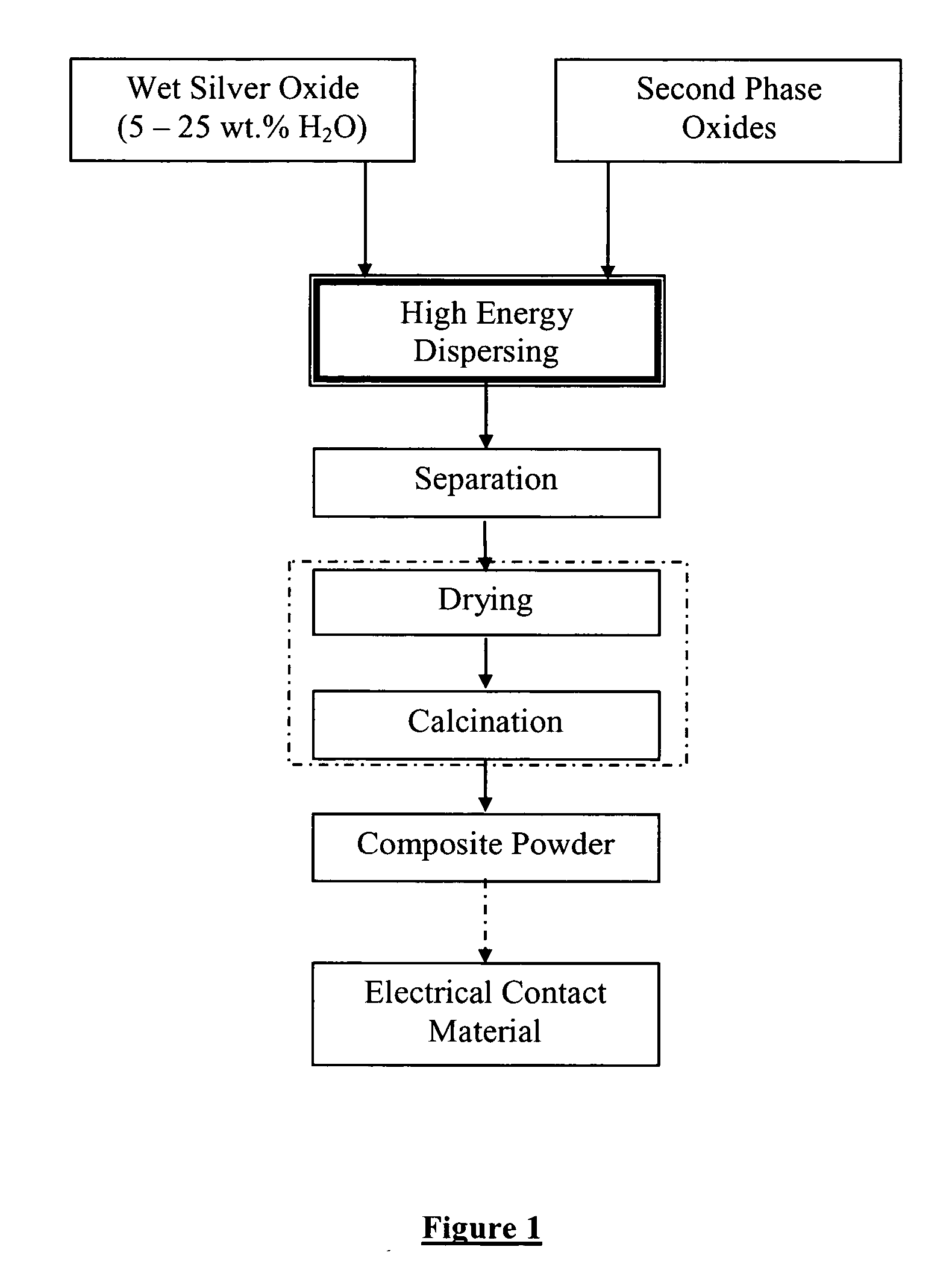Process for manufacture of silver-based composite powders for electrical contact materials and composite powders so produced
a technology of composite powders and electrical contact materials, which is applied in the direction of copper compounds, non-metal conductors, conductors, etc., can solve the problems of difficult to obtain very finely dispersed silver-based contact materials, limited to relatively coarse powders, and difficult to meet the technical limits of conventional mixing techniques
- Summary
- Abstract
- Description
- Claims
- Application Information
AI Technical Summary
Benefits of technology
Problems solved by technology
Method used
Image
Examples
example 1
Preparation of Silver-Tin Oxide Composite Powder by High Shear Mixing
[0056] (Composition: 90 wt.-% Ag, 7.2 wt.-% SnO2, 2.3 wt.-% In2O3, 0.5 wt.-% CuO)
[0057] The following components are weighed into a PE bucket filled with approx. 12 L DI water:
Ag2O (res. moisture: 12 wt.-% H2O):1,624.0g (= 1,350 g Ag)SnO2 (d50 = 750 nm):108.0gIn2O3 (d50 = 800 nm):34.5gCuO (d50 = 850 nm):7.5g
[0058] Ag2O was prepared from a commercially available AgNO3 solution, the residual moisture content of Ag2O was 12 wt.-% H2O.
[0059] For preparing the suspension by high shear mixing, the mixture was dispersed with the Kinematica device (conditions: starting temperature 25° C., 20 mins at 7,200 rpm, then 5 mins at 9,600 rpm; end temperature 45° C.).
[0060] The aqueous suspension was then filtered off and dried overnight at 70° C. in air. Thereafter, the composite powder was heat-treated for 2 h at 390° C. in order to reduce the silver oxide (Ag2O) to metallic silver. Then the powder was screened through a 2...
example 2
Preparation of Silver-Tin Oxide Composite Powder by High Energy Milling (Attritor)
[0063] (Composition: 88 wt.-% Ag, 11.6 wt.-% SnO2, 0.4 wt.-% WO3)
[0064] The following components are weighed separately:
Ag2O (res. moisture: 11 wt.-% H2O):735.0g (= 616 g Ag)SnO2 (d50 = 750 nm):81.2gWO3 (d50 = 900 nm):2.8g
[0065] Ag2O was used with a residual moisture content of 11 wt.-% H2O. The equipment used for high energy milling was a bench type Szegvary attritor, model 01-HD, manufactured by Union Process, Akron, Ohio, USA. In order to eliminate the contamination of the samples with iron, a ceramic milling tank / agitator assembly was used. The milling media consisted of yttrium stabilized zirconia balls. The jacketed milling tank was connected to a constant temperature bath, which maintained the temperature at 19° C. through the entire milling process.
[0066] The attritor was first loaded with 300 mL DI water. The required amount of silver- and tin oxides was then gradually added and mixed at ...
PUM
| Property | Measurement | Unit |
|---|---|---|
| Temperature | aaaaa | aaaaa |
| Temperature | aaaaa | aaaaa |
| Distance | aaaaa | aaaaa |
Abstract
Description
Claims
Application Information
 Login to View More
Login to View More - R&D
- Intellectual Property
- Life Sciences
- Materials
- Tech Scout
- Unparalleled Data Quality
- Higher Quality Content
- 60% Fewer Hallucinations
Browse by: Latest US Patents, China's latest patents, Technical Efficacy Thesaurus, Application Domain, Technology Topic, Popular Technical Reports.
© 2025 PatSnap. All rights reserved.Legal|Privacy policy|Modern Slavery Act Transparency Statement|Sitemap|About US| Contact US: help@patsnap.com



